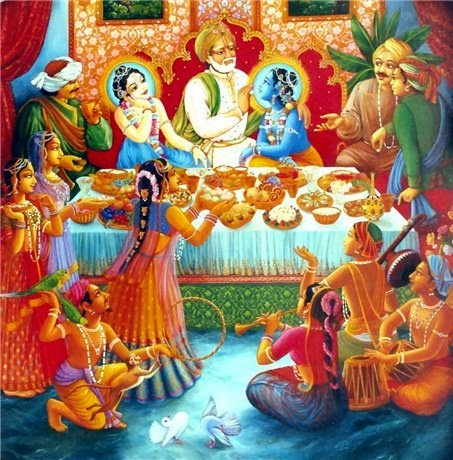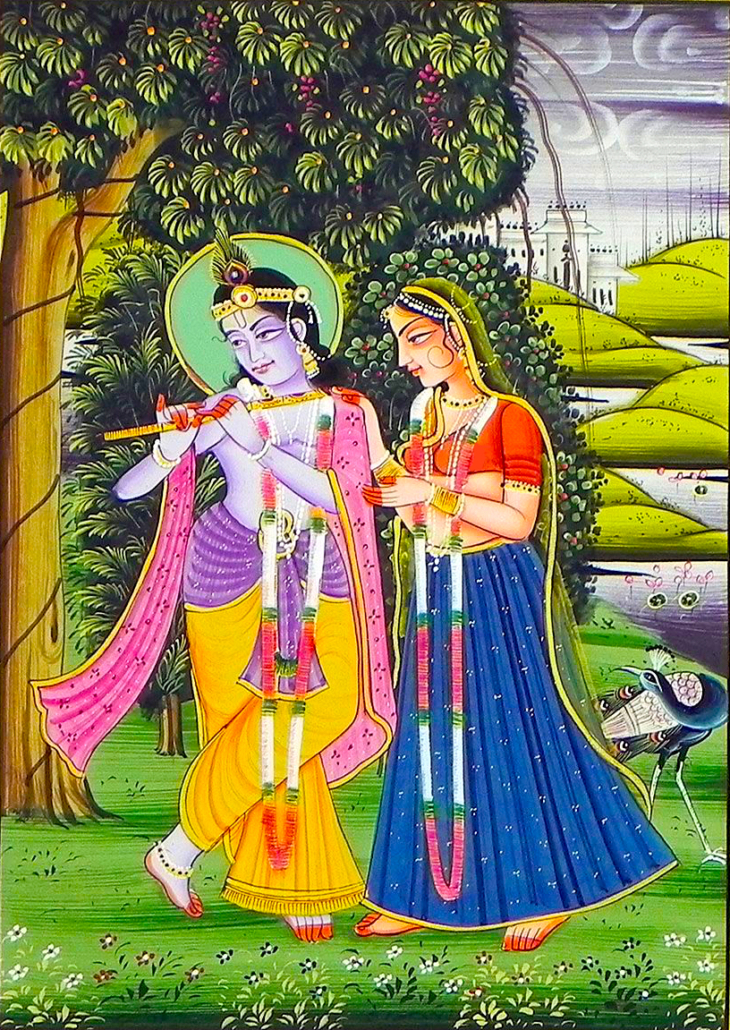Mahanidhi Madan Gopal Das
The Witch Becomes a Mother
The Supreme Brahman, taking the form of a human being, descended on earth and assumed the mood of a village boy. Although He appeared like an ordinary human to the common people, Sri Krishna, who is famous as the beautiful form of supreme transcendence, has a completely pure spiritual body. Manifesting along with His divine consort Srimati Radharani, Krishna fully satisfied the minds of everyone.
Once, Vrajaraja Nanda, having accepted the customs of ordinary people, followed the proper etiquette to protect his city. Nanda and other senior men went to Mathura to pay taxes to King Kamsa for their yearly milk production. The Yadus and their faithful servants accompanied him.
Meanwhile, in Mathura, the cruel and wicked Kamsa, remembering his past enmity toward Lord Vishnu, tactfully sent Putana rakshasi to Vrindavana to kill baby Krishna. She was as foreboding as an evil planet. Capable of assuming any form, Putana disguised herself as the most beautiful woman in the three worlds and went to Nanda’s capital. The villagers became attracted and bewildered by seeing such an exceptionally charming woman. In this way, Putana astonished the minds of everyone with her superbly enchanting form.
Seeing the extraordinary elegance of Putana, the Vrajavasis openly mocked the famous society girls of heaven, saying, “O Urvasi! You are the best of the heavenly damsels, but in the presence of Putana you are no more than a beggar! O Rambhe! Very soon you will become the consort of a frog. O Ghitachi! Your fame is now as valuable as a crematorium covered by water. O Citralekhe! Your captivating form appears now like lines in a painting.”
The Vrajavasis, speculating as to the identity of Putana, thought, “Is this lady the presiding demigoddess of Vrindavana? Is she the goddess of fortune of the three worlds? Is she a creeper of lightning appearing without a cloud? Is she a friend of the kumuda flowers blossoming under the moon?”
When Putana entered Yasoda’s home, the Vrajavasis concluded that the goddess of the three worlds had favored that great soul, the King of Vrindavana by personally coming to render all kinds of service. Baby Krishna lay on a bed as white as the rays of the full moon, or the foam produced from churning the ocean of milk. Nandulala looked like a great emerald sprouting from a field of powdered camphor.
Putana played the part of the sweet deceiver who outwardly speaks pleasing words, but harbors cruelty within his vicious heart. She exactly resembled a well concealed by straw in order to trap a wild elephant. Her attractive form rivaled the jeweled sheath of a deadly sword. Although assuming the form of a desire creeper, Putanawas really a poisonous plant.
Displaying motherly affection, Putana held Nandu in her lap. Yasoda and Rohini wondered, “Is this woman Bhagavati Gauri? Or is she the presiding deity of the material elements? Is she the consort of Indra, the queen of Varuna, or the consort of Agnideva? Has she appeared here to display affection toward my son?” Thinking thus, they did not prevent Putana from offering her breast milk to the baby.
Fearlessly, Putana picked up baby Krishna and cuddled Him in her lap. The compassionate Lord, who is absolute knowledge personified, acted as if He was unaware of the situation. Krishna immediately accepted Putana as His mother and climbed up on her lap. Yasoda and Rohini watched attentively as Putana expressed motherly affection toward Krishna by pressing her poison covered nipple into His mouth. Krishna’s soft, copper-colored lips resembled drinking cups made of the petals of a cluster of bandhuka flowers. Expert at performing pastimes, Krishna skillfully sucked out both Putana’s milk and her very life, which left her helpless and stupefied.
Feeling intense pain, Putana shrieked, “Please leave me, leave me!” while trying her best to throw the baby off her breast. But Krishna held tightly with both hands and sucked her breast milk with the cup of His soft lips. Then Putana assumed her raksasi form as a horrible demon. Krishna immediately killed her and cast Putana’s huge and hideous body out of town to prevent her crushing the Vrajavasis. However, when Putana fell to the ground, her dead body smashed all of Kamsa’s favourite mango trees in his fruit orchard. The ugly body of Putana extended for twelve miles.
The Vrajavasis froze in fright upon seeing the gigantic body of that witch. Everyone was amazed to see Krishna sitting playfully in the rakshasi’s lap. Yasoda sighed, “Alas! How painful, what happened to my son? While thus lamenting, Yasoda staggered a few steps and fell senseless. But the moment she heard that her son was safe and sound, Vrajesvari Yasoda regained her consciousness.
To relieve His grieving family and friends, Krishna crawled up on Putana’s chest so they could see Him freely playing there. Upon seeing Krishna, the gopas cried out, “O look! That woman came to kill the son of Nanda, but she died as a result of her grave offense. O how fortunate we are!” Beholding that gentle yet fearless, beautiful boy with a sweet smile, the cowherd men picked Krishna up and handed Him from one to another.
The gopis consoled Yasoda, “O pious one, here is your son, please embrace Him.” Yasoda swelled with joy upon seeing her son’s face. Thereafter, Yasoda and Rohini, along with the other elderly gopis, waved about the switch of a cow, bathed the beautiful child with cow’s urine, and performed other purifying acts to create auspiciousness. To further protect the child they chanted the holy names of the Lord.
The Vrajavasis chopped up the gigantic body of Putana, took it away, and burned it. From a distance that burning body, spewing forth deep black smoke and many sparks, looked like a monsoon cloud illuminated by streaks of lightning. Because Krishna had touched Putana the smoke rising from her burning body filled every planet up to Vaikuntha with a sweet aroma. Everyone enjoyed that fragrance which smelled like incense of aguru and sandalwood. The rain falling through that fragrant smoke saturated the earth with a sweet smell.
Vrajaraja Nanda returned from Mathura amidst all this commotion. Observing the smoke and feeling apprehensive, the associates of Nanda said, “O King of Vrindavana, what is this dense cloud of dark blue smoke?” Moving closer to Putana, the elderly gopas wondered, “Where has all this aromatic smoke suddenly come from? Has the fragrance of the earth expressing its desire to conquer the sky, taken the form of smoke to spread throughout the world?”Thus, the gopas argued amongst themselves about the amazing event.
Vrajaraja Nanda anxiously said, “What happened? What is wrong?” Within minutes the Vrajavasis assembled before Nanda Maharaja and told him all about Putana’s demoniac deeds. Upon seeing the face of his beloved child, Nanda felt relieved and refreshed. Picking up Gopala, Nanda Baba affectionately smelled His head. Overwhelmed with unlimited pleasure, his mind melted with ecstatic feelings and his eyes streamed tears of happiness.
Who can describe the mercy of the Lord? Even though Putana rakshasi came disguised as a mother to kill Krishna with her poisonous breast milk, the compassionate Sri Krishna gave her the position of a mother in the spiritual world.
Anandakanda Bhagavan Sri Krishna ki jai! Vrajalila ki jai!
Kaviraja Sri Karnapura Goswami’s Ananda Vrindavana Campu ki jai!
Jai Jai Sri Radhe!
All parts of Krishna Nectar Lilas can be found here.


